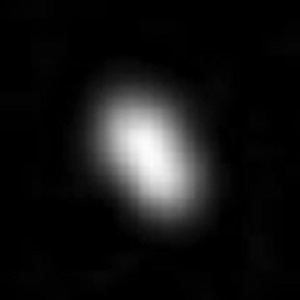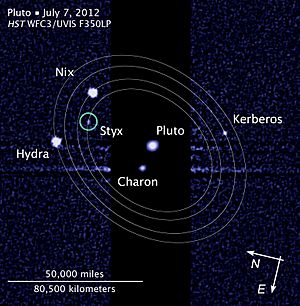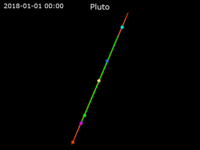Styx (moon) facts for kids

Pluto's moon Styx, as seen by the New Horizons spacecraft on 13 July 2015, from a distance of 632,000 km
|
|
| Discovery | |
|---|---|
| Discovered by | Showalter, M. R. et al. |
| Discovery site | Hubble Space Telescope |
| Discovery date |
|
|
Detection method
|
Photographic |
| Designations | |
| MPC designation | Pluto V |
|
Named after
|
Στύξ Styx |
| S/2012 (134340) 1 S/2012 P 1 |
|
| Adjectives | Stygian |
| Orbital characteristics | |
| 42656±78 km | |
| Eccentricity | 0.005787±0.001144 |
| 20.16155±0.00027 d | |
| Inclination | 0.809°±0.162° |
| Satellite of | Pluto |
| Physical characteristics | |
| Dimensions | 16 × 9 × 8 km |
| Mass | 7.5×1015 kg |
|
Sidereal rotation period
|
3.24 ± 0.07 d (chaotic) |
| 82° (to orbital plane) | |
| Albedo | 0.65 ± 0.07 geometric |
| 27±0.3 | |
Styx is a small moon of Pluto. Scientists announced its discovery on July 11, 2012. It was found using the powerful Hubble Space Telescope. Styx is the smallest of Pluto's five known moons.
The New Horizons spacecraft took a picture of Styx in July 2015. It was part of its mission to explore Pluto and its moons. Styx is the second-closest moon to Pluto and the fifth one discovered. It was found about a year after another moon called Kerberos. Styx is shaped like a potato, measuring about 16 kilometers (10 miles) at its longest point. It takes about 20.1 days for Styx to orbit Pluto.
Contents
Discovering Styx
A team of astronomers, led by Mark R. Showalter, found Styx. They used images taken by the Hubble Space Telescope between June 26 and July 9, 2012. The discovery was shared with the world on July 11, 2012.
Styx is very dim, only about half as bright as Kerberos, which was the dimmest moon known before Styx. It's also about 100,000 times fainter than Pluto itself. When it was first found, Styx was called S/2012 (134340) 1. People also informally called it "P5," meaning Pluto's fifth moon.
Scientists were looking for new moons to help plan the New Horizons mission. This robotic spacecraft flew past Pluto on July 14, 2015. Finding another small moon like Styx made scientists wonder if there were even more tiny objects or rings around Pluto. They worried these could harm the spacecraft as it zoomed through space at over 13 kilometers (8 miles) per second. Luckily, New Horizons passed through the Pluto system safely. It did not find any smaller moons or rings that could cause problems.
How Pluto's Moons Formed
Scientists believe that Pluto's complex moon system might have formed from a huge crash. This collision likely happened long ago between Pluto and another large object from the Kuiper belt. The moons we see today probably came together from the pieces left over from this giant impact. This idea is similar to how Earth's Moon is thought to have formed. The way the moons orbit Pluto, in a very organized way, might have helped gather the debris from the collision.
What Styx Is Made Of
Scientists first guessed that Styx was between 10 and 25 kilometers (6 to 15 miles) wide. They based this on how bright it looked and how much light they thought it reflected. But when New Horizons flew by, it found that Styx is shaped like an uneven blob. Its measurements are roughly 16 by 9 by 8 kilometers (10 by 5.6 by 5 miles).
Scientists think Styx formed from the debris of a collision. This kind of event would have caused lighter materials, like nitrogen and methane ice, to escape. So, Styx is probably made mostly of water ice.
Styx's Orbit
Styx orbits the center of mass between Pluto and its largest moon, Charon. This center is called the barycenter. Styx is about 42,656 kilometers (26,505 miles) away from it. This places Styx's orbit between Charon and Nix.
All of Pluto's moons travel in orbits that are almost perfectly round and flat. Mark Showalter, who discovered Styx, described them as "neatly nested," like Russian nesting dolls.
Styx's orbit is linked to the orbits of Hydra and Nix in a special way. This is called an orbital resonance. It means their orbital periods are related by simple ratios. For example, Styx completes 11 orbits for every 6 orbits of Hydra.
Styx's orbital period is about 20.16 days. This is close to being three times longer than the orbital period of Pluto and Charon. Styx, along with Nix, Kerberos, and Hydra, forms an unusual pattern of "near resonances" in their orbital periods. While Styx's orbit is stable, its rotation is not. Unlike many moons, Styx is not "tidally locked" to Pluto. This means its rotation speed changes over short periods, about every 3.24 days.
Naming Styx
Before any of Pluto's moons were found, a science fiction writer named Edmond Hamilton wrote about three moons of Pluto in 1940. He called them Charon, Styx, and Cerberus.
When Styx was discovered, it was given the scientific name S/2012 (134340) 1. This name means it was the first moon (S) found orbiting the minor planet 134340 Pluto in 2012. People also informally called it "P5," because it was the fifth moon found around Pluto.
Pluto's moons are usually named after characters or places related to the god Pluto in classical mythology. To choose names for P4 (Kerberos) and P5 (Styx), Mark Showalter and the SETI Institute held an online poll in 2013. The public could vote for their favorite names from a list of Greek mythological names. They could also suggest their own.
William Shatner, the actor famous for playing Captain Kirk in Star Trek, suggested the names Vulcan and Romulus. Vulcan was a popular choice in the poll. However, the International Astronomical Union (IAU) did not accept "Vulcan." This was because Vulcan is not an underworld figure, and the name had already been used for a hypothetical planet and a group of asteroids.
On July 2, 2013, the IAU officially approved the names Styx for P5 and Kerberos for P4. Styx is named after the goddess of the river Styx in the underworld.
See also
 In Spanish: Estigia (satélite) para niños
In Spanish: Estigia (satélite) para niños




